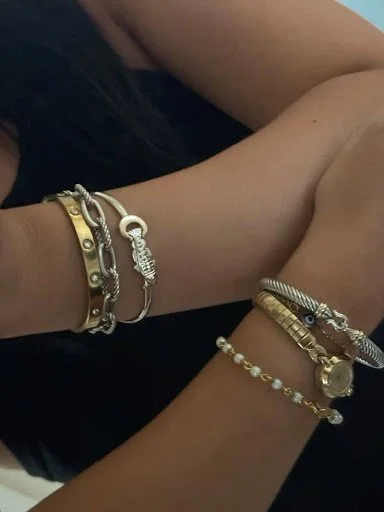Mixed Metals: Melting the Barriers of Jewelry
Are you the moon or the sun? Are you night or day? Are you silver or gold?
Was it Buzzfeed quizzes that encouraged us early on to label ourselves as one thing or identify with a singular category? Did we take questionnaires like “What Disney princess are you?” or “What season matches your personality” too literally? Have we internalized the notion that we must stick to one fashion palette, the same way we were instructed as children to pick our favorite color and stick with it for a while?
In reality, things don’t have to be so black and white.
Yes, there’s nothing wrong with finding your niche and sticking with it—but fashion doesn’t have to feel so restrictive. Fashion should be about expression and self-exploration, fluid, and ever-evolving.
While we often circle through trends in jewelry, such as the spike in the popularity of rose-gold jewelry in the mid-2010s, we can’t be expected to buy a whole new set of jewelry each time a new tone of metal is declared “in.” That's just unrealistic and wasteful. All precious metals are precious in different ways:
Silver jewelry is typically more accessible, since stainless steel, AKA 925 sterling silver, is of strong quality, durable, and affordable compared to fine silver. On the other hand, most affordable gold jewelry contains metals like copper, silver, and nickel, which are susceptible to tarnishing. Higher-quality gold, such as 14k gold, gold-filled, or even 24k gold, is more of a long-term investment due to the cost. Affordable silver jewelry often looks more like real silver, whereas faux or gold-plated jewelry often doesn’t look as refined. With the real deal, however, solid gold stands the test of time and tends to be more durable than fine silver, which may require regular polishing.
Silver is a trusty, contemporary option that will never clash with an outfit. Gold is more of a rich, classic color—though it can overpower an outfit if used excessively. Both tones are stunning, respectively, but the two don’t have to compete. Gold and silver can complement one another, like PB&J. Sure, peanut butter and jelly can be delicious on their own: there is no harm in eating a plain peanut-butter sandwich. However, adding a touch of jelly can greatly advance the flavor profile, so the sandwich becomes multi-dimensional and assumes a new, joint identity. Soon enough, it’s hard to imagine ever reverting to just peanut butter, because PB&J becomes a package deal. Silver and gold are striking on their own—but together, they form a shiny, textual relationship with a nuanced personality, and it’s hard to imagine one without the other.
Even other tones of metal, such as rose-gold, white-gold, and titanium, can harmonize similarly. Although rose-gold and white-gold are not opposites like gold vs. silver, they can enhance one another’s shades and create a playful, colorful relationship. Mixing rose-gold, silver, and gold all together may become a bit of an overwhelming palette for some, but it depends on your personal preference. For example, some people like adding bananas to a PB&J sandwich, while others prefer the classic duo.
Some consider it “illegal” in the name of fashion to mix gold and silver. Yet, the beauty of accessorizing is that there are no real rules. You may have chosen to be a “silver” person at age ten when you got your first pair of earrings—but that doesn’t mean wearing your Grandma’s vintage gold watch will illegitimize your fashion-identity. Instead of dividing the metals, we should be mixing them.
Not only do mixed metals add depth and dynamism to a simple outfit, but they also give the ultimate effortless, cool effect. The statement is high-fashion, eclectic, and without words, says: “I can’t be bothered to stick to one theme; so I’ll do it all.”
Jewelry is all about making a statement. Could it be that the next “statement” jewelry trend is not gold or silver, but both?
Not only is it becoming more popular to mix different silver and gold pieces, but brands are catching on and designing more pieces that incorporate both metals into one:
Of course, silver and gold can complement different undertones, such as pale and olive, in different ways, either accentuating or washing out an individual’s features. So, mixing metals doesn’t have to be a 50-50 balance, and can rather include whispers of variation.
For example, to build an ultimate ring stack, instead of going for all gold, throw in an accent silver ring on one finger.
The moon and sun can be friends. Day can’t exist without night. Although seemingly opposites, silver and gold can be comrades. Jewelry is ageless, genderless, both minimalistic and maximalistic, fancy and casual, and will never go out of style. Plus, there is no set formula for mixing and matching, so get creative with it!







